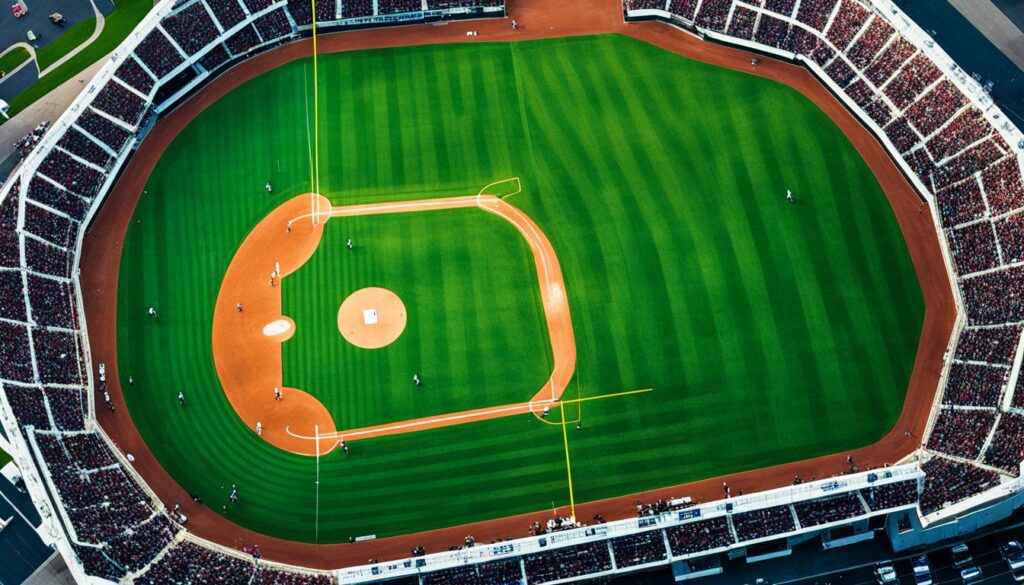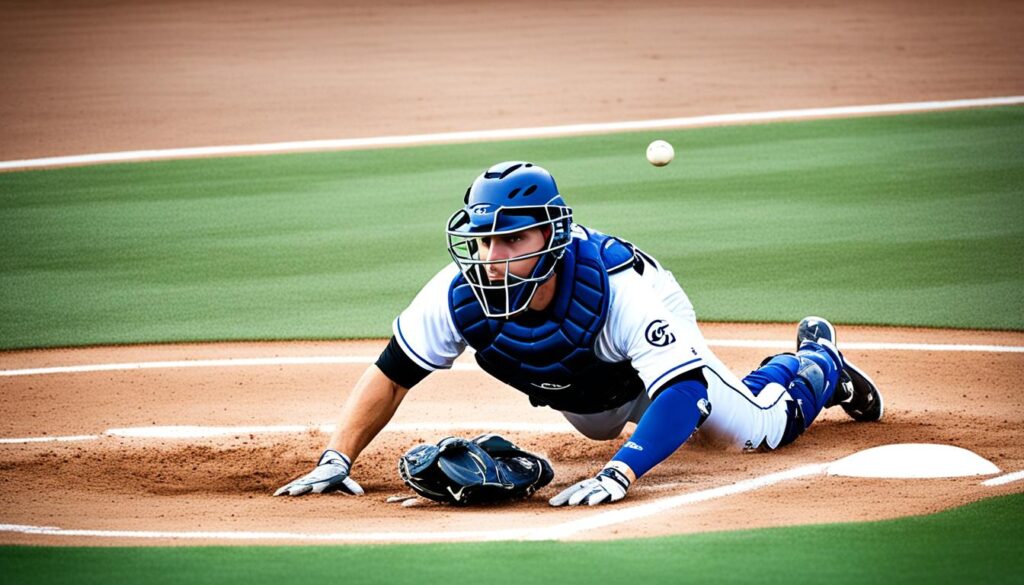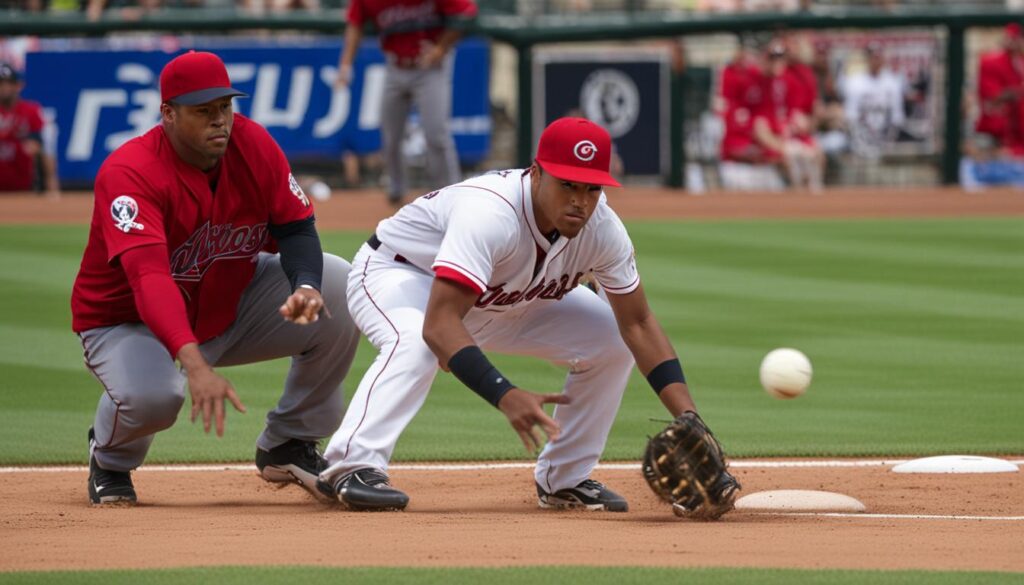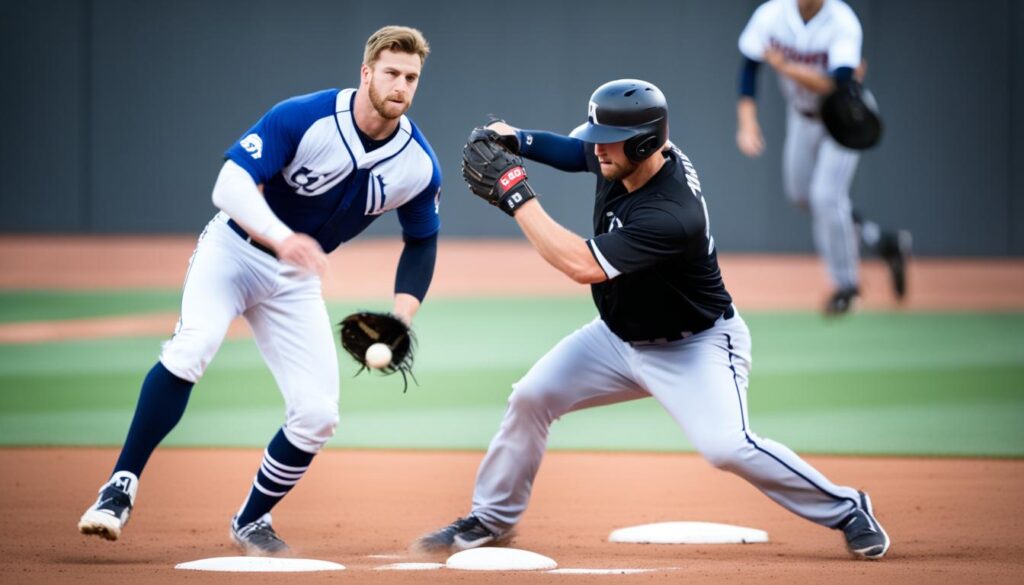
Have you ever wondered what each player’s role is on a baseball field? Do you know the difference between the pitcher, the catcher, and the outfielders? Whether you’re a fan of the sport or a player looking to deepen your understanding, it’s essential to grasp the basic field positions in baseball.
In the sport of baseball, each player on a team is assigned a specific fielding position. These positions are traditionally numbered, with the pitcher being assigned the number 1, followed by the catcher (number 2), first baseman (number 3), second baseman (number 4), third baseman (number 5), shortstop (number 6), left fielder (number 7), center fielder (number 8), and right fielder (number 9).
These positions are grouped into three categories: the outfield, the infield, and the battery. The pitcher and catcher are highly specialized positions and rarely play at other positions. But what are their specific responsibilities? And what about the other field positions?
Key Takeaways:
- Each baseball field position has a specific number and role, from the pitcher to the outfielders.
- The pitcher’s main responsibility is to throw the ball toward home plate and achieve outs against batters.
- The catcher has multiple tasks, including catching pitches, calling plays, and leading the infield.
- First basemen are responsible for fielding balls hit in their direction and serving as a target for other infielders.
- Second basemen have defensive skills and are skilled in turning double plays.
The Role of the Pitcher
In the game of baseball, the pitcher holds a crucial position on the field. Tasked with throwing the ball towards home plate, their main objective is to achieve outs against the opposing batters. A successful pitcher possesses a wide array of pitches in their arsenal, including fastballs, curveballs, and changeups, each intended to deceive and challenge the batter.
The ultimate goal of the pitcher is to either strike out the batter or induce them to hit a pitch that can be caught by a defending player, resulting in an out. This requires a combination of precision, strategy, and skill. Additionally, pitchers play an important role in preventing base stealing by paying close attention to baserunners and employing pick-off moves to keep them in check.
Furthermore, pitchers have the ability to control the pace of the game. They dictate the rhythm and flow of play, setting the tone for each inning. Their performance can either energize their team or demoralize the opposing side. With their every throw, pitchers have the power to influence the outcome of the game.
Overall, the role of the pitcher in baseball is one of immense responsibility and impact. Their presence on the mound is a constant challenge to the opposing team, and their performance can be the difference between victory and defeat.
The Responsibilities of the Catcher
In the game of baseball, the catcher is an integral part of the defensive strategy. Their primary responsibility is to catch the pitches thrown by the pitcher. However, their role extends far beyond that. Let’s explore the various responsibilities of a catcher in detail:
- Catching Pitches: The catcher’s main job is to receive the pitches thrown by the pitcher. They must have excellent hand-eye coordination and quick reflexes to catch the ball accurately.
- Calling Pitches: The catcher plays a crucial role in calling the right pitches in coordination with the pitcher. They must read the game situation and have a deep understanding of the strengths and weaknesses of the opposing batters.
- Blocking Errant Pitches: Sometimes, the pitcher may throw a pitch that is difficult to catch. In such cases, the catcher must block the ball to prevent it from getting past them and allowing baserunners to advance.
- Monitoring Baserunners: The catcher keeps a close eye on baserunners, ensuring they don’t attempt to steal bases. They communicate with the infielders to make pickoff throws or catch runners off-guard.
- Directing the Infield: When the ball is in play, the catcher is responsible for directing the infielders and positioning them optimally based on the game situation. Their experience and knowledge of the opposing team’s tendencies play a crucial role in this aspect.
- Throwing Out Runners: If a baserunner attempts to steal a base, the catcher must quickly gather the ball and make a strong, accurate throw to the appropriate infielder to tag the runner out, a skill known as “throwing out runners.”
The catcher is often considered the leader of the infield, providing guidance and direction to the entire team. They play a vital role in formulating defensive strategies and ensuring that the team operates smoothly on the field.

“The catcher is the backbone of the team; without them, the defense would crumble.” – Joe Torre
The Duties of the First Baseman
In the game of baseball, the first baseman plays a critical role in the field. Their primary responsibility is to field balls hit in their direction and attempt to get the opposing player out. As one of the infield positions, the first baseman occupies a strategic spot near the first base bag, ready to make quick and accurate plays.
One of the key duties of a first baseman is to pick bad throws from other infielders. Since other players may occasionally make errant throws, the first baseman needs to have exceptional reflexes and the ability to scoop low or high throws to prevent the opposing players from advancing on the bases.
Additionally, the first baseman acts as a big target for other infielders to throw to. Their position near first base allows them to receive throws from the other infielders and record outs by stepping on first base before the baserunner reaches there. The first baseman’s size and reach make them an excellent target for infielders, ensuring that fielding plays are executed smoothly.
First basemen are often known for their power hitting abilities. They are typically strong and have excellent batting skills that allow them to hit the ball for distance. Their offensive contribution to the team is valuable, as they can hit home runs or drive in runs to score points for their team.
Handling line drives hit towards first base requires quick reflexes and instincts. First basemen need to react swiftly and position themselves to catch the ball, preventing it from reaching the outfield and allowing opposing players to advance on the bases. Their ability to make these plays often determines the success of the defensive effort.
To summarize, the first baseman plays a crucial role in the game of baseball. They field balls hit in their direction, pick bad throws, act as a target for other infielders, and contribute offensively by hitting for power. The first baseman’s reflexes, instincts, and overall fielding skills are essential for the team’s success.

| Key Responsibilities | Skills Required |
|---|---|
| Fielding balls hit towards first base | Reflexes |
| Picking bad throws | Instincts |
| Being a target for other infielders | Size and reach |
| Contributing offensively | Power hitting abilities |
The Skills of the Second Baseman
Second basemen in baseball are highly skilled players who excel in defensive capabilities, agility, and quickness. They play a crucial role in the team’s defense and contribute significantly to the overall strategy and success of the game.
One of the primary responsibilities of a second baseman is fielding ground balls and fly balls that come within their designated area. They must have excellent reflexes and instinctively react to quickly catch or field the ball. Their agility allows them to cover a large area, making difficult plays and preventing the opposing team from gaining an advantage.
“As a second baseman, you need to be quick on your feet, always anticipating where the ball may be hit. It’s essential to have exceptional defensive skills and the ability to make split-second decisions.” – Roberto Alomar
A crucial skill that sets second basemen apart is their ability to turn double plays. When a groundball is hit, the second baseman must swiftly touch second base and make a precise, accurate return throw to first base to complete the double play. This requires a combination of speed, coordination, and timing, making it a challenging task that requires extensive practice and skill development.
In addition to their defensive prowess, second basemen often possess a good baseball IQ. They have a deep understanding of the game, allowing them to anticipate plays, read batters’ swings, and position themselves favorably to make plays. This knowledge contributes to their overall effectiveness on the field and enhances their decision-making abilities.
Another aspect that highlights the skills of second basemen is their prowess as contact hitters. These players are known for their ability to make consistent, solid contact with the ball, often placing it strategically to advance baserunners and contribute to scoring opportunities.
| Skills of the Second Baseman | ||
|---|---|---|
| Defensive Skills | Agility | Quickness |
| Ability to field ground balls and fly balls | Turn double plays | Good baseball IQ |
| Skilled contact hitter |
Overall, second basemen are versatile players with excellent defensive skills, the ability to turn double plays, and contribute as contact hitters. Their impact on the game goes beyond statistics, as their quick reflexes, agility, and strategic thinking add tremendous value to the team’s defensive efforts.

The Role of the Shortstop
Shortstops are considered the leaders of the infield. Positioned between second and third base, they play a crucial role in the defense of a baseball team. Their responsibilities include fielding ground balls, making accurate throws, and turning double plays in conjunction with the second baseman. Shortstops must possess exceptional range, quick reflexes, and strong arms to excel at their position. They are often involved in critical game situations that require them to make split-second decisions and adapt to changing circumstances.
To be effective, shortstops need to have excellent defensive skills and a deep understanding of the game. They must anticipate where the ball will be hit and position themselves accordingly. The ability to read the batter’s swing and react swiftly is essential for a shortstop to make challenging plays. Furthermore, shortstops must possess the arm strength to throw the ball accurately across the diamond, completing outs and preventing base runners from advancing.
“The shortstop is the captain of the infield, leading by example with their exceptional fielding and playmaking abilities.” -Alex Rodriguez
Shortstops often act as the primary communicator on the infield, directing other fielders and coordinating defensive strategies. Their leadership skills extend beyond physical abilities and require strong situational awareness and communication. They are responsible for keeping their teammates informed of potential plays, shifts, and positioning adjustments based on the batter, game situation, and scouting reports.
In addition to their defensive prowess, shortstops are expected to contribute offensively. Many modern shortstops possess power, agility, and speed, making them valuable assets at the plate and on the base paths. Their offensive production, combined with their defensive skills, elevates the shortstop position to one of the most important and dynamic roles in baseball.
Key Skills of a Shortstop:
- Excellent range and quickness
- Strong arm for accurate throws across the diamond
- Quick reflexes and excellent fielding abilities
- Leadership and communication skills
- Ability to turn double plays
Shortstops play a pivotal role in the success of a baseball team, contributing both offensively and defensively. Their ability to make outstanding plays, lead the infield, and impact the outcome of a game makes them true difference-makers on the field.
| Shortstop | Teams | Gold Glove Awards | All-Star Appearances |
|---|---|---|---|
| Derek Jeter | New York Yankees | 5 | 14 |
| Ozzie Smith | St. Louis Cardinals | 13 | 15 |
| Cal Ripken Jr. | Baltimore Orioles | 2 | 19 |
The Responsibilities of the Third Baseman
The third baseman, as the name suggests, is responsible for playing the third base position in baseball. This position is crucial in the defense of the game, and the third baseman plays a vital role in the success of the team.
One of the primary responsibilities of the third baseman is to field balls hit in their direction and try to get the opposing player out. This requires good fielding skills and quick reflexes because balls hit to third base tend to come quickly. The third baseman must be agile and have exceptional hand-eye coordination to make clean plays on grounders and line drives.
In addition to their fielding skills, third basemen often have strong arms, which allow them to make long throws across the diamond. These accurate and powerful throws are necessary to complete outs and prevent opposing players from reaching base safely. Third basemen also need to communicate effectively with their teammates to execute double plays smoothly and cover different areas of the field.
Overall, the third baseman is a crucial position that requires a combination of defensive skills, quick reflexes, and a strong throwing arm. They play a significant role in the team’s defensive strategy and contribute to the success of the game.

| Responsibilities of the Third Baseman | Skills required |
|---|---|
| Fielding balls hit in their direction | Good fielding skills and quick reflexes |
| Making accurate and powerful throws | Strong throwing arm |
| Executing double plays | Effective communication and coordination with teammates |
The Duties of the Outfielders
In the game of baseball, the outfielders play a crucial role in the defensive strategy of the team. They are responsible for patrolling the outfield area, which includes left field, center field, and right field. Let’s take a closer look at the duties of these outfielders.
The Left Fielder
The left fielder is positioned in left field, which is the area between third base and center field. Their primary duty is to catch fly balls hit to the left side of the outfield. They also need to prevent home runs by reaching over the fence if necessary. The left fielder must have excellent catching and throwing abilities to make plays and assist other fielders.
The Center Fielder
The center fielder is positioned in center field, which is the area between left field and right field. They have a critical role in covering a large portion of the outfield. The center fielder must have exceptional speed and agility to chase down fly balls hit to all areas of the outfield. They need to make accurate throws to other positions and prevent base stealing by intimidating baserunners with their strong arm.
The Right Fielder
The right fielder is positioned in right field, which is the area between center field and first base. Their main responsibility is to catch fly balls hit to the right side of the outfield and prevent extra-base hits. The right fielder must have good anticipation and excellent throwing ability to make strong and accurate throws to other positions on the field.
Together, the left fielder, center fielder, and right fielder form a formidable outfield defense. They must communicate effectively, back each other up, and coordinate their movements to make plays and prevent runs from scoring. Their ability to track down fly balls, make accurate throws, and cover the outfield area is vital to the team’s success.
| Outfield Position | Primary Duty | Key Skills |
|---|---|---|
| Left Fielder | Catch fly balls hit to the left side of the outfield | Catching, throwing, preventing home runs |
| Center Fielder | Cover a large portion of the outfield, catch fly balls hit to all areas | Speed, agility, accurate throwing, preventing base stealing |
| Right Fielder | Catch fly balls hit to the right side of the outfield | Anticipation, strong arm, accurate throwing, preventing extra-base hits |
The Importance of Fielding in Baseball
Fielding is a crucial aspect of baseball, as it involves preventing the opposing team from scoring runs. Fielders must possess several key skills to excel in their respective positions. These skills include the ability to catch the ball effectively, throw accurately, and have good reflexes to stop and retrieve hit balls.
Fielders often find themselves in situations where they need to run, dive, and slide to make plays. These acrobatic maneuvers require agility and coordination. Additionally, fielders must be able to quickly transfer the ball to another fielder to record an out, showcasing their ability to make accurate throws under pressure. The defensive performance of a team heavily relies on the fielders’ ability to execute these fundamental aspects of the game.
Each fielding position has specific responsibilities and contributes to the overall defensive strategy of the team. The positions are strategically assigned to players based on their individual skills and strengths. For example, outfielders cover a large area of the field and prioritize catching fly balls and preventing home runs. In contrast, infielders, such as the third baseman and shortstop, need to demonstrate quick reflexes and strong arms to field ground balls and make accurate throws to get the opposing players out.
Fielding in baseball requires not only technical skills but also mental focus and game awareness. Fielders need to anticipate potential plays, read the game situation, and position themselves accordingly. By being proactive and responsive, fielders can make critical plays that impact the outcome of the game.
Ultimately, fielding is an essential component of a well-rounded baseball team. A strong defense can complement the efforts of the pitchers and contribute to the overall success of the team. Without skilled fielders in their respective positions, baseball games would lack the excitement and intensity that stems from tight defensive plays and remarkable feats of athleticism.
Conclusion
Understanding the basic field positions in baseball is crucial for both players and fans. Each position plays a unique role and holds specific responsibilities that contribute to the overall success of the team. From the pitcher’s ability to control the game to the catcher’s leadership on the field, every position in baseball has a significant impact on the outcome of the match.
By grasping the intricacies of these positions, players can gain a deeper appreciation for the strategies and dynamics involved in the sport. They can better understand the importance of teamwork and how each player’s role complements and supports the others. Furthermore, fans can enhance their enjoyment of the game by recognizing and appreciating the individual skills and contributions of each position player.
Whether it’s the pitcher’s precision and power, the catcher’s agility and game management, or the fielders’ range and throwing accuracy, baseball positions are vital components in the intricate tapestry of the sport. By mastering and executing their respective roles, players create a synergy that leads to success on the field. So next time you watch a baseball game, take a moment to acknowledge the importance of each position and the collective effort they represent.
Recommended
- FROM THE DIAMOND: THE PSYCHOLOGY BEHIND CATCHERS’ THIRD BASE THROWS
- ELEVATE YOUR GAME WITH EXPERT BASEBALL TIPS

Meet Daniel Anderson, the heart and soul behind Baseball Pro Picks. At 49, Daniel’s life has revolved around baseball, a passion that’s as strong today as it was when he first fell in love with the game. Living in the USA, Daniel has dedicated countless hours to watching, analyzing, and understanding every pitch, hit, and home run, making almost no game missed. His deep-rooted love for the sport is matched only by his commitment to sharing insightful, expert analysis with fellow baseball enthusiasts. With decades of experience and a keen eye for the game’s nuances, Daniel brings a unique perspective that enriches Baseball Pro Picks. Trust Daniel to guide you through the intricacies of baseball with the authority and trustworthiness of a true aficionado.












